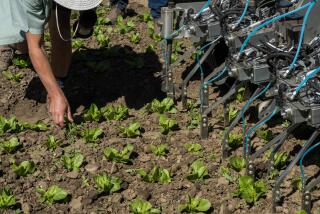Sprouting a new line of produce seeds
- Share via
CREVE COEUR, MO — Monsanto Co., whose genetically modified corn and soybeans have reshaped America’s heartland and rallied a nation of fast-food foes, wants to revolutionize the produce aisle.
The agribusiness giant already has quietly stepped into the marketplace with produce grown from its seeds.
Grocery customers in California and elsewhere are chopping its onions that produce fewer tears, stir-frying its broccoli that decreases cholesterol and biting into tiny orange tomatoes that last longer on the shelf.
Soon, people will be thumping melons bred to be a single serving and shucking sweet corn genetically modified to enable farmers to spray the fields with the company’s weed killer, Roundup.
To do this, it’s marrying conventional breeding methods with its vast technological resources to bring about changes in fruits and vegetables in months or years, rather than in decades.
Monsanto’s goal: to dominate today’s $3-billion global market for produce seeds, much as it already has done with corn and soybeans.
“This isn’t a hobby.... We’re serious about it,” said Monsanto Chief Executive Hugh Grant, who expects the company’s vegetable seed revenue to rival its $1.5-billion soybean business in the coming decade.
The move has raised the hackles of some environmental and organic farming groups that fear it will ultimately squeeze out smaller, independent vegetable seed firms.
They also worry that the company will use technology to introduce revolutionary new genes into vegetable plants, just as Monsanto scientists have done in corn, soybeans and cotton.
“Clearly, the company wants to keep its options open,” said Doug Gurian-Sherman, senior scientist with the food and environmental program at Union of Concerned Scientists. “But I think they understand it’s a dicey proposition to move into [genetically engineered] foods that are widely consumed, rather than foods that are highly processed or used as animal feed.”
Monsanto officials said the opportunities for growth in the vegetable seed market were too good to ignore. They said there were plenty of ways to use technology to design better-tasting vegetables, yet avoid the financial and consumer hurdles that would inevitably come with rolling out genetically engineered produce for a grocery store.
The amount of arable land worldwide is dwindling, while the world’s population is forecast to jump to more than 9 billion by 2050 from nearly 6.9 billion today. Shifts in weather patterns have caused recent slumps in key crops.
All this, in turn, has water-strapped countries eager to establish secure food supplies. Fast-growing economies, such as those in India and China, also are stepping up food imports to feed a burgeoning middle class.
Given these factors, Monsanto is making a multibillion-dollar bet that global farming conditions are going to get tougher and farmers are going to be hungry for their vegetable and fruit seeds.
Revenue from Monsanto’s vegetable seed business totaled $895 million for the company’s fiscal year that ended Aug. 31. That’s about 8% of its annual revenue, a figure the company hopes to grow steadily in coming years.
Monsanto moved aggressively into the vegetable business in 2005 when it bought seed powerhouse Seminis Inc. in Oxnard. Since then, it has acquired four other vegetable seed companies, opened 57 research centers worldwide and hired a slew of seed geneticists and agricultural researchers.
Today, Monsanto has about 4,000 employees -- nearly a fifth of its 21,000 global labor force -- working on its vegetable seed business worldwide.
It has nearly doubled the staff at its test farm and research greenhouses in Woodland, Calif., a farm community 18 miles west of Sacramento, where much of the company’s vegetable seed research happens.
Dozens of varieties of tomatoes, hot peppers and onions fill the 144-acre farm facility, where company researchers walk the fields each day, inspecting specimens and collecting samples to study under a microscope.
“A lot of technologies we’ve used for years are very applicable to vegetables,” said Marlin Edwards, chief technology officer for Monsanto’s vegetable seeds division, who is based in Northern California.
Monsanto is relying on a strategy similar to the one it tapped to dominate the world of commodity crops: Use technology to speed up the breeding process. The goal is to create produce that tastes better and plants that yield more product, while letting farmers use fewer resources.
Monsanto officials are quick to stress that they are not creating genetically modified crops. In its Roundup Ready soybeans, for example, Monsanto developed seedlings with genes from a soil bacterium to help the plant to survive being sprayed with its herbicide.
With vegetables, scientists are looking for answers in the same, or similar, varieties of plants. So a trait in one pepper, such as flavor, might be meshed with the DNA of another pepper. The technique has been helpful developing vegetable plants that can withstand certain pests, said Consuelo Madere, vice president of Monsanto’s global vegetable group.
Such techniques speed up the conventional breeding process, Madere said.
“Our researchers have found natural resistances in the DNA of wild-grown peppers,” Madere said. “So why not breed that resistance into the seed? You don’t need [biotech] for something that nature has already figured out.”
But some scientists say this is genetic modification -- just a different type.
“What they really are doing is creating something where the probability is very low that it would have happened in nature without human intervention,” said R. Paul Thompson, director of graduate studies at the University of Toronto’s department of ecology and evolutionary biology.
Although Monsanto has made billions of dollars selling biotech corn and soybeans, which are used in animal feed and processed food, it has generally shied away from investing in biotech products sold directly to consumers.
Part of the reason is simple economics. Biotech seeds typically take years to clear government regulatory systems in the U.S. and elsewhere before they are sold and sown. Non-biotech seeds can be brought to market faster.
Part of the reason, too, is to avoid the headaches of public controversy. The company ran into that problem in the 1990s and early 2000s with its NewLeaf potato.
The bio-engineered potato was developed to repel the Colorado potato beetle. But major French fry manufacturers and McDonald’s, which were worried about the public debate over whether biotech crops were safe, barred their growers from raising the genetically modified potatoes.
Monsanto ultimately shelved the product line.
Now the company is focused on its better-breeding approach.
Consumers now can buy Beneforte broccoli, which Monsanto claims has twice as much antioxidant benefit than typical broccoli varieties. There’s the company’s EverMild onion, which has lower sulfur levels and causes fewer tears when cut. And there’s the orange grape tomato, which is bred to be sweeter, with a lower acidity level and a richer fragrance than conventional grape tomatoes.
Monsanto, however, hasn’t ruled out the idea of genetically modified vegetables. After all, genetically engineered produce has already made some inroads into U.S. grocery stores.
The University of Hawaii’s genetically modified papaya, resistant to the papaya ringspot virus, has been growing and sold for years. Biotech giant Syngenta has been selling biotech sweet corn for nearly a decade.
Monsanto’s entry into biotech sweet corn will hit U.S. farm fields later this year. The company is waiting for regulatory approval for a variety of eggplant in India that is resistant to some insects.
--
More to Read
Inside the business of entertainment
The Wide Shot brings you news, analysis and insights on everything from streaming wars to production — and what it all means for the future.
You may occasionally receive promotional content from the Los Angeles Times.










